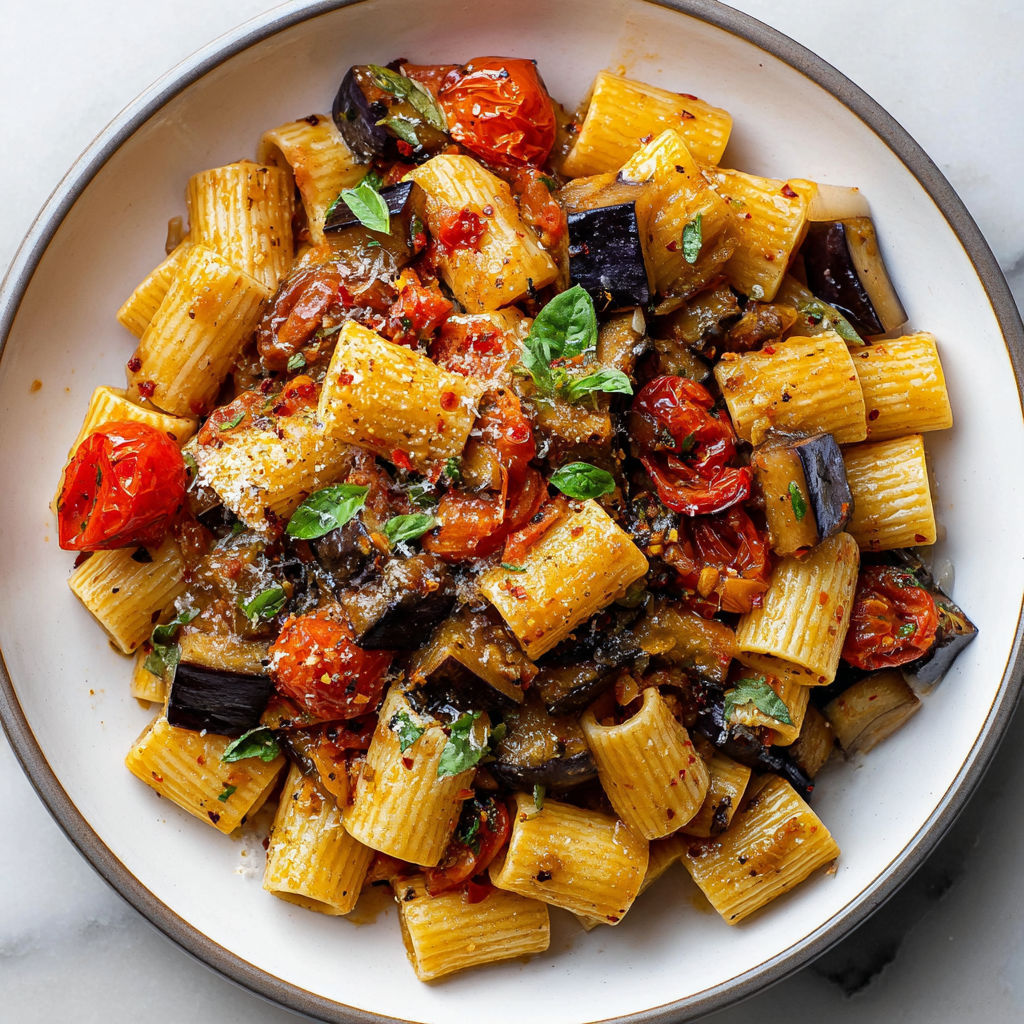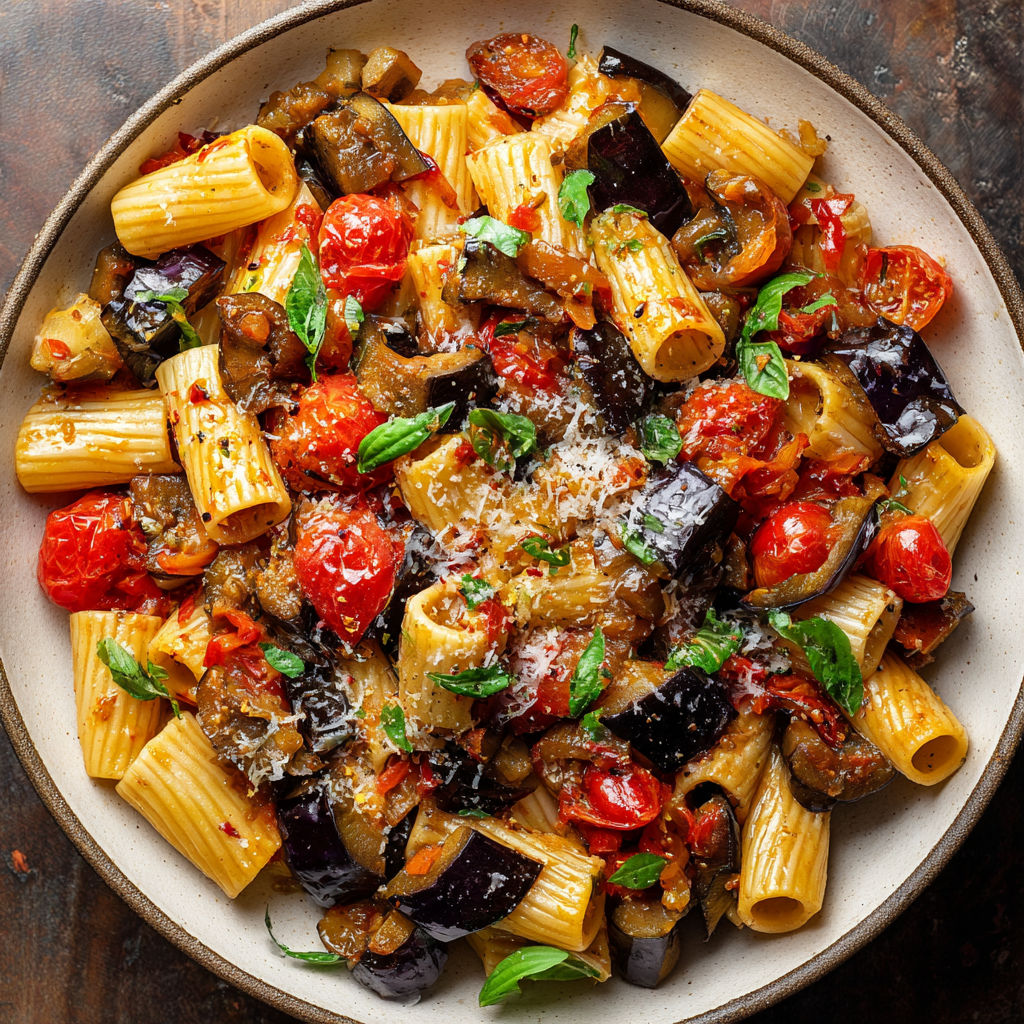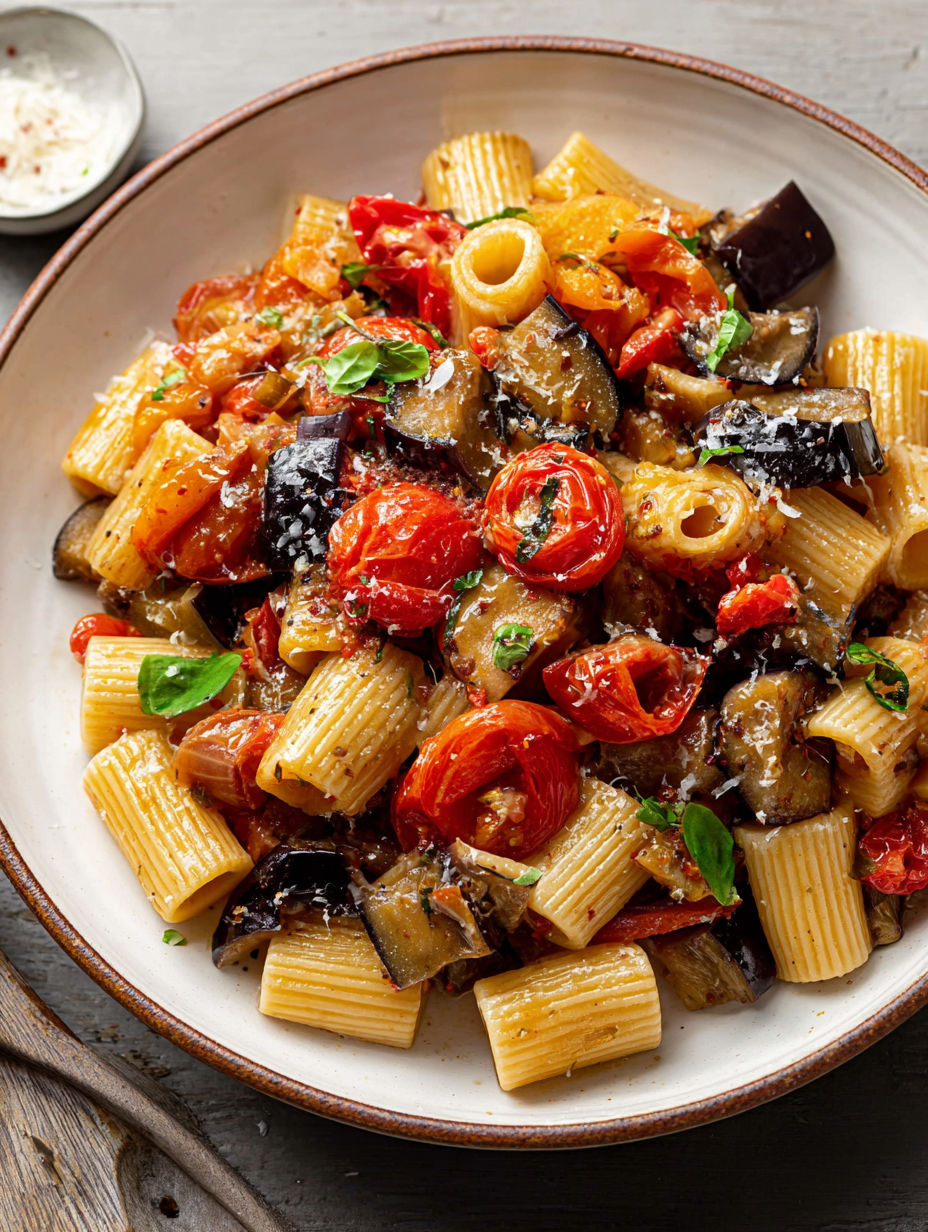 Pin
Pin
This roasted eggplant pasta celebrates late-summer produce with a light, bright-tasting sauce that transforms humble vegetables into a memorable vegetarian meal. The combination of golden roasted eggplant and juicy tomatoes creates a dish that's both comforting and fresh, perfect for those evenings when you crave something substantial yet not heavy.
I first made this pasta during a particularly abundant eggplant harvest from my garden. The transformation of those humble purple globes into something so luxurious convinced even my eggplant-skeptic partner to request it regularly throughout tomato season.
- Globe eggplants select firm ones with glossy skin and a slight heaviness for their size
- Extra virgin olive oil use your best bottle here as the flavor really shines through
- Cherry tomatoes multicolored varieties add visual appeal and slightly different flavor notes
- Large ripe tomatoes summer heirlooms are ideal but any very ripe tomato will work wonderfully
- Onion provides the aromatic foundation for the sauce
- Garlic cloves fresh is non-negotiable for the best flavor
- Crushed red pepper flakes adjust to your heat preference or omit entirely
- Short tubular pasta shapes like rigatoni catch the chunky sauce perfectly
- Fresh basil adds brightness and that signature Italian aroma
- Parmesan cheese splurge on Parmigiano-Reggiano for the most authentic finish
How To Make Eggplant and Fresh Tomato Pasta
- Roast the eggplant
- Cube your eggplant consistently for even cooking, then toss generously with olive oil to prevent sticking and promote caramelization. Spread in a single layer giving each piece breathing room if possible. The roasting transforms eggplant from spongy to silky with concentrated flavor.
- Blister the cherry tomatoes
- These little gems need just enough heat to soften and begin releasing their sweet juices without completely collapsing. The brief roast intensifies their natural sweetness while maintaining their structural integrity in the final dish.
- Prepare the fresh tomato sauce
- Grating ripe tomatoes is the genius technique that creates a fresh sauce in minutes. The large holes of a box grater separate pulp from skin effortlessly, giving you pure tomato essence without blanching or peeling. The resulting sauce has a garden-fresh brightness that canned tomatoes simply cannot match.
- Build the flavor base
- Sautéing onions until translucent creates a sweet foundation, while briefly cooking garlic releases its aroma without burning. This step layering flavors is what distinguishes a good pasta sauce from a great one.
- Combine components
- Folding the roasted eggplant and blistered tomatoes into the sauce creates textural contrast and flavor complexity. Each component maintains its identity while contributing to the cohesive whole.
- Finish in the pasta water
- The magic happens when the pasta completes its cooking in the sauce, absorbing flavors while releasing starch that thickens everything to the perfect consistency. This restaurant technique elevates the entire dish, creating a harmonious marriage between pasta and sauce.
I find the moment when the grated tomatoes hit the hot pan absolutely magical. The immediate aroma that fills the kitchen reminds me of my grandmother's garden kitchen in late August, when she would spend entire days preserving the summer bounty for winter meals. This simple technique of grating tomatoes rather than peeling and chopping them was her little secret that I now pass along to friends.
Perfect Pasta Selection
The pasta shape matters significantly in this dish. Short, tubular shapes with ridges or grooves work best because they capture bits of eggplant and tomato in each bite. My personal favorites are paccheri or rigatoni, whose substantial walls stand up to the chunky sauce elements. Avoid delicate shapes like angel hair which would get lost among the vegetables.
Eggplant Preparation Tips
Salting eggplant before cooking was once considered essential to draw out bitterness, but with modern varieties, this step is rarely necessary. The high-heat roasting method in this recipe achieves the perfect texture without the extra time. However, do make sure to cut uniform pieces for even cooking, and use enough oil to promote browning without steaming.
Seasonal Adaptations
While this dish shines brightest with summer produce, you can adapt it year-round. In winter, substitute good quality canned crushed tomatoes for the fresh, and consider adding a tablespoon of tomato paste for depth. You might also incorporate winter herbs like rosemary or thyme along with the basil for a more seasonal approach.

Storage and Serving Suggestions
While this pasta is best enjoyed immediately after cooking, leftovers can be stored in an airtight container for up to three days. The flavors often deepen overnight, making this a great make-ahead dish. Reheat gently with a splash of water to loosen the sauce. For serving, consider a simple arugula salad dressed with lemon and olive oil to complement the richness of the pasta.

Recipe FAQs
- → Can I use different types of pasta for this dish?
Yes! While the recipe recommends short tubular shapes like rigatoni, ziti, or paccheri that catch the sauce well, you can substitute with penne, fusilli, or even spaghetti. The key is cooking it very al dente (2 minutes less than package instructions) as it will finish cooking in the sauce.
- → How can I make this dish vegan?
To make this dish vegan, simply omit the Parmesan cheese or replace it with a plant-based alternative. Nutritional yeast can provide a similar umami flavor, or you could try a sprinkle of toasted breadcrumbs mixed with lemon zest for texture and brightness.
- → What's the best way to choose eggplants for this dish?
Look for globe eggplants that feel firm and heavy for their size with smooth, shiny skin. Smaller eggplants tend to have fewer seeds and less bitterness. The stem should be green and fresh-looking. Avoid eggplants with brown spots, wrinkles, or those that feel spongy when pressed.
- → Can I prepare any components ahead of time?
Yes! You can roast the eggplant and cherry tomatoes and prepare the tomato sauce a day in advance. Store each component separately in the refrigerator. When ready to serve, reheat the sauce, add the roasted vegetables, and proceed with cooking the pasta and finishing the dish.
- → What can I serve with this pasta?
This pasta works beautifully as a main dish paired with a simple green salad dressed with lemon vinaigrette. For a more substantial meal, serve with garlic bread or focaccia. A glass of medium-bodied red wine like Sangiovese or Montepulciano d'Abruzzo complements the tomato and eggplant flavors perfectly.
- → Why is it important to save the pasta water?
Pasta water is crucial for creating a silky, cohesive sauce. The starchy water helps bind the sauce to the pasta and creates the perfect consistency. Without it, the dish would be too dry. The eggplant also absorbs some of this starchy water, becoming even more tender and flavorful.
